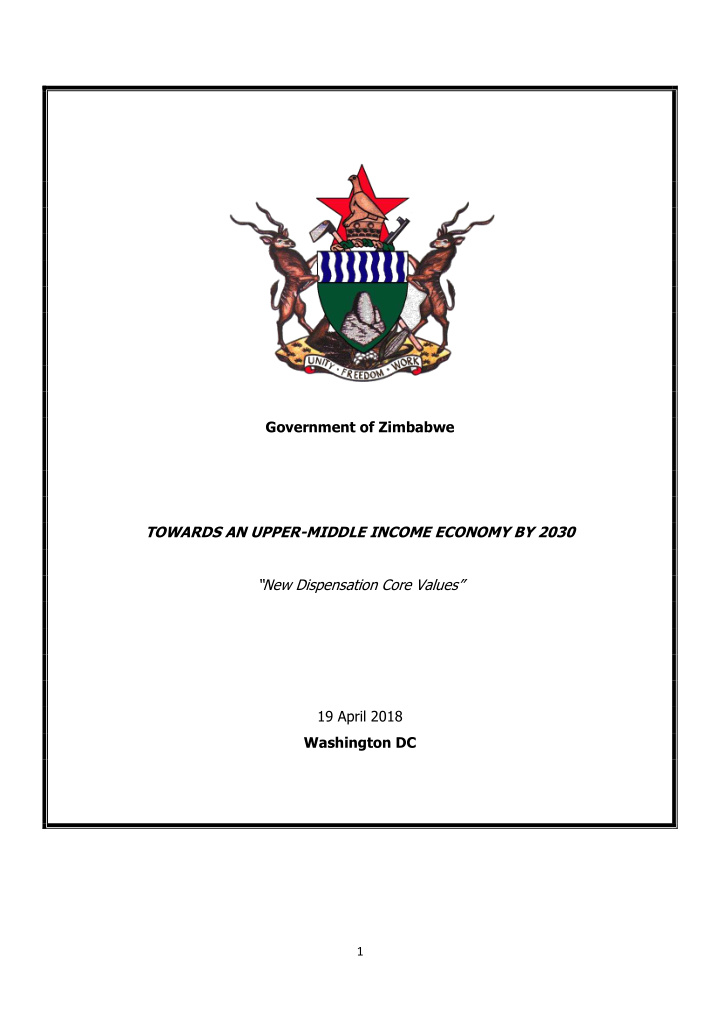



Government of Zimbabwe TOWARDS AN UPPER-MIDDLE INCOME ECONOMY BY 2030 “New Dispensation Core Values” 19 April 2018 Washington DC 1
Zimbabwe: Some Key Facts Location Southern Africa, at the heart of the North-South Corridor, making Zimbabwe ’s railways, roads, power and telecommunications network a regional logistics hub. Total Area 390 757 sq. km Land 386 670 sq. km Water 4 087 sq. km Border Countries Botswana to the West; Mozambique to the East, South Africa to the South, Namibia to the South West, and Zambia to the North. Capital City Harare Climate Tropical, with temperatures averaging 12 – 13 Deg. C. over April – July and 21 – 38 Deg. C, over August to October. The rainy season is during October - March. Population Census of 2012 indicated 13.1 million. Average Annual Population Growth Rate of 2.3%. Literacy Literacy levels of 94.7%. Financial Inclusion Overall financial inclusion estimated at above 58% for adults. Major Economic Sectors Agriculture; 11%, Mining, 9%, Manufacturing 8%, Tourism, 12% and Services, 16% of GDP. Inflation Annual rate of below 3%. Enabling Infrastructure Road network of 88 133km, Rail network of 3 109km; Widespread internal and external air links. There are 3 International airports and 18 other smaller airports servicing domestic and regional flights. Modern ICT systems, with current Mobile Penetration rate of 100.5%, Internet Penetration rate of above 50%. 2
Installed power generation capacity of over 2 300 MW, with potential to develop over 2 000MW additional power. Diverse internal power grid and a link to the external grid – the Southern African Power Pool. Preferential Market Access Southern African Development Community (SADC), Common Market for Eastern and Southern Africa (COMESA); and Africa Caribbean and Pacific Nations (ACP), as well as membership of the World Trade Organization. 3
CONTENTS NEW DISPENSATION .................................................................................... 6 Strategy Thrust ................................................................................................. 7 Compensation of Former Farm Owners .............................................................. 8 Arrears Clearance and Debt Restructuring .......................................................... 9 DEMOCRATISATION AND GOVERNANCE .................................................... 10 Servant Leadership ......................................................................................... 11 Respect for Human Rights ............................................................................... 11 National Unity, Peace and Reconciliation .......................................................... 12 Tolerance, Freedom of Speech and Association ................................................. 12 Harmonised General Elections .......................................................................... 13 THE ECONOMY ............................................................................................ 15 Pursuing Tenets of a Market Economy .............................................................. 18 Fiscal Consolidation ......................................................................................... 19 Expenditure Management ................................................................................ 21 Resource Mobilisation ...................................................................................... 24 Public Enterprise Reform ................................................................................. 25 EASE OF DOING BUSINESS ......................................................................... 29 Openness to Business ..................................................................................... 29 Indigenisation Legislation ................................................................................ 30 Ease of Doing Business Reforms ...................................................................... 31 Bilateral Investment Protection ........................................................................ 32 One Stop Shop Investment Centre ................................................................... 33 Exchange Control Liberalisation ....................................................................... 34 Labour Market Flexibility .................................................................................. 35 SECTORAL OPPORTUNITIES ....................................................................... 35 Agriculture ...................................................................................................... 35 Investment in Mining ...................................................................................... 38 Industry ......................................................................................................... 39 Tourism .......................................................................................................... 40 Infrastructure Rehabilitation and Development ................................................. 41 4
Scope & Scale of Inf r astructure Needs ............................................................. 44 Financial System ............................................................................................. 44 Social Protection ............................................................................................. 45 CROSS-CUTTING THEMES .......................................................................... 46 Fighting Corruption ......................................................................................... 46 Performance Culture in the Public Service ......................................................... 48 Protection of the Environment ......................................................................... 48 CONCLUSION .............................................................................................. 49 ANNEXURES ................................................................................................ 51 5
NEW DISPENSATION 1. This Policy Document seeks to share with the international community at large, as well as domestic stakeholders, our key reform initiatives and commitments, under the New Dispensation, on rebuilding and transforming Zimbabwe to become an Upper-Middle Income Economy by 2030. 2. The Document further outlines an update of the “Lima Agenda” , giving milestones and progress attained so far, as well as our next steps towards a new Zimbabwe. 1 3. The New Political Dispensation follows more than 18 years of economic isolation and erosion of investor confidence, which has seen Zimbabwe losing phenomenal ground in terms of development. 4. The formation of the New Government therefore, provides an opportunity for reconstruction and transformation of the economy to one which is capable of creating maximum opportunities for people to live a full and dignified life, taking advantage of the immense and diverse domestic resource endowments, tapping into investment prospects from international markets. 5. The transformation process will require fixing of broken relations and rebuilding bridges with cooperating partners both at home and abroad. 6. It also entails restoring and establishing essential principles and systems, which enhance our democracy and development agenda. 7. Such robust and progressive principles and systems guide the current Administration and constitute a solid base for future generations, without a repeat of slippages as witnessed during the last two decades. 1 See Annex 1: Matrix of Policy Reform A separate Executive Summary to this Statement is also attached 6
8. As a people, we are aware of our errors and omissions, which have contributed to past leadership failures that retarded development. 9. Therefore, we say “ let ‘Bygones be Bygones’ and, accordingly, the New Dispensation commits to our departure from living in the past and focus on the future, also taking on-board valuable lessons from the history. 10. As we look forward, the new leadership commits itself to fully play its role and cooperate with the international community for a prosperous and peaceful Zimbabwe, which is also embraced by the Community of Nations. Strategy Thrust 11. The new Government is cognisant of the huge resource requirements for re- building the economy and has prioritised investment, a key ingredient for powering the economy. 12. This is anchored on a fiscal policy framework that allows for realisation of Budget savings, supportive of re-orienting expenditures away from consumption towards development. 13. The expenditure rationalisation measures announced in the 2018 National Budget mark the onset of the fiscal rationalisation reforms under the new Dispensation. 14. Government, however, recognises that the private sector remains the engine of sustainable future growth. 15. In this regard, to facilitate domestic private sector investment, the new Government is speeding up the ongoing Ease of Doing Business Reform. 7
Recommend
More recommend